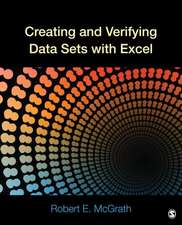Conversations About Group Concept Mapping: Applications, Examples, and Enhancements
Autor Mary A. Kane, Scott R. Rosasen Limba Engleză Paperback – 21 ian 2018
Preț: 443.36 lei
Preț vechi: 521.61 lei
-15% Nou
Puncte Express: 665
Preț estimativ în valută:
84.83€ • 88.81$ • 70.20£
84.83€ • 88.81$ • 70.20£
Carte tipărită la comandă
Livrare economică 07-21 aprilie
Preluare comenzi: 021 569.72.76
Specificații
ISBN-13: 9781506329185
ISBN-10: 1506329187
Pagini: 312
Dimensiuni: 187 x 232 x 13 mm
Greutate: 0.43 kg
Ediția:1
Editura: SAGE Publications
Colecția Sage Publications, Inc
Locul publicării:Thousand Oaks, United States
ISBN-10: 1506329187
Pagini: 312
Dimensiuni: 187 x 232 x 13 mm
Greutate: 0.43 kg
Ediția:1
Editura: SAGE Publications
Colecția Sage Publications, Inc
Locul publicării:Thousand Oaks, United States
Cuprins
Introduction
Acknowledgments
About the Authors
SECTION I
Chapter 1. Simple Rules for Constructing Group Knowledge: The What and How of GCM
By the Book: The Textbook Definition of GCM
A “Group Wisdom” Definition
GCM’s Simple Rules: The Participant as Knowledge Holder
How GCM is Used
Where GCM is Used
Chapter 2. GCM in Action: Capturing Knowledge, Valuing Participation
GCM’s Simple Rules: What We Ask of the Participant
The Researcher’s Roles in GCM
Designing and Conducting GCM: The Project Process Model
Orientation to the Model: Roles in GCM
The GCM Process: An Exemplar
Idea Generation
Data Development and Phase II Planning
Organizing
A Sample of a Sorting and Rating
Chapter 3. GCM in Action: Analyzing for Results, Producing the Map
Analysis
Looking at the Maps
Ratings Comparisons
Interpretation
Glossary: Commonly Used Terms in Group Concept Mapping
SECTION II
Chapter 4. Conversations on Group Concept Mapping With Guest Researchers: Introduction
Chapter 5. A Conversation on Needs of At-Risk African American Youth in Chicago
Design Decisions and Technical Innovations
Chapter 6. A Conversation on Regional Economic Development and Cultural Entrepreneurship
Design Decisions and Technical Innovations
Chapter 7. A Conversation on the Future of Learning: New Ways to Learn New Skills for Future Jobs
Design Decisions and Technical Innovations
Chapter 8. A Conversation on Promoting Readiness for Living, Learning, and Working for Youth Who Have Disabilities Who Receive Supplemental Security Income (SSI)
Design Decisions and Technical Innovations
Chapter 9. Synthesis: What We’ve Learned
Participation
Representation and Visualization
Utilization
Integrated, Mixed-Method Approach
Conclusion
Chapter 10. Forward
Appendices
A. Bibliography
B. GCM Project Workbook
C. Technology for Managing and Conducting GCM
D. Guest Researchers’ Biographies
References
Index
Acknowledgments
About the Authors
SECTION I
Chapter 1. Simple Rules for Constructing Group Knowledge: The What and How of GCM
By the Book: The Textbook Definition of GCM
A “Group Wisdom” Definition
GCM’s Simple Rules: The Participant as Knowledge Holder
How GCM is Used
Where GCM is Used
Chapter 2. GCM in Action: Capturing Knowledge, Valuing Participation
GCM’s Simple Rules: What We Ask of the Participant
The Researcher’s Roles in GCM
Designing and Conducting GCM: The Project Process Model
Orientation to the Model: Roles in GCM
The GCM Process: An Exemplar
Idea Generation
Data Development and Phase II Planning
Organizing
A Sample of a Sorting and Rating
Chapter 3. GCM in Action: Analyzing for Results, Producing the Map
Analysis
Looking at the Maps
Ratings Comparisons
Interpretation
Glossary: Commonly Used Terms in Group Concept Mapping
SECTION II
Chapter 4. Conversations on Group Concept Mapping With Guest Researchers: Introduction
Chapter 5. A Conversation on Needs of At-Risk African American Youth in Chicago
Design Decisions and Technical Innovations
Chapter 6. A Conversation on Regional Economic Development and Cultural Entrepreneurship
Design Decisions and Technical Innovations
Chapter 7. A Conversation on the Future of Learning: New Ways to Learn New Skills for Future Jobs
Design Decisions and Technical Innovations
Chapter 8. A Conversation on Promoting Readiness for Living, Learning, and Working for Youth Who Have Disabilities Who Receive Supplemental Security Income (SSI)
Design Decisions and Technical Innovations
Chapter 9. Synthesis: What We’ve Learned
Participation
Representation and Visualization
Utilization
Integrated, Mixed-Method Approach
Conclusion
Chapter 10. Forward
Appendices
A. Bibliography
B. GCM Project Workbook
C. Technology for Managing and Conducting GCM
D. Guest Researchers’ Biographies
References
Index
Notă biografică
Mary Kane, MSLIS, is President of Concept Systems, Inc., a social research and evaluation firm specializing in capturing the knowledge and opinions of people and agencies to improve organizations, cultures and environments. Ms. Kane assesses and addresses the needs of local, national and international agencies, guiding government offices, foundations, professional associations, corporations and academic and research institutions to awareness, consensus and decisions. A special emphasis in Mary¿s work is creating awareness of ¿group wisdom¿ in a community or organization, and guiding groups to harness collective knowledge to produce meaningful, measurable and useful outcomes for program, policy and population change. Ms. Kane is author or co-author of many publications on the applications of Group Concept Mapping (GCM) in organizational decision-making and strategic planning and evaluation. Her current research focuses on ¿Valuing Voice¿ in underrepresented communities to support sustainable change; and expanding the definition of competencies for evaluation. As first author of the authoritative text on concept mapping, Concept Mapping for Planning and Evaluation, Mary was able to use her deep knowledge in partnership with Dr. Rosas to create, in this volume, an exciting expansion of GCM¿s story
Descriere
Conversations About Group Concept Mapping: Applications, Examples, & Enhancements takes a concise, practice-based approach to concept mapping. After defining the method, demonstrating how to design a project, and providing guidelines to analyse the results, the book then dives into real research exemplars.

















